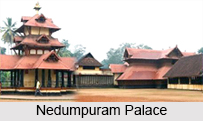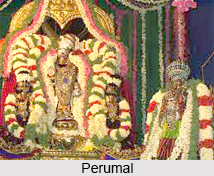 Nedumpuram Palace is a famous palace in Kerala. This palace belonged to the family of Kulasekhara.
Nedumpuram Palace is a famous palace in Kerala. This palace belonged to the family of Kulasekhara.
Location of Nedumpuram Palace
Nedumpuram Palace is now a tourist destination situated in Tiruvalla in Pathanamthitta District of Kerala.
Family in Nedumpuram Palace
Nedumpuram Palace belongs to a branch of the Kulasekhara dynasty that ruled the principality of Udayamangalam in Northern Kerala. The family belongs originally to the Valluvanad royal line of ascension who presided over the Mamamkam festival. During the southern campaign of Tipu Sultan, the family relocated to the south of Kerala and took shelter under the patronage of the King of Travancore.
Parts of the family of Nedumpuram Palace
The family of Nedumpuram Palace is divided into two branches establishing principalities within Travencore in Mariapalli and Tiruvalla. The current palace stands at the earlier location of a palace that belonged to the Raja of Tiruvalla.
 Architecture of Nedumpuram Palace
Architecture of Nedumpuram Palace
Nedumpuram Palace is constructed in the traditional complex "pathinaru kettu" structure (lit. 16 blocks) which divided the structure into four blocks of rooms with indoor open courtyards connected to each other. The structure is supported by teak beams and false ceilings. At present the building is in disrepair. It is built in the kovilakam style. A single block of this architecture is called Nalukettu and is generally constructed as a single dwelling of many joint families. For each block of `Nalukettu`, barring the foundation and floor is made of carved and slotted wood and has a close resemblance to East Asian gabled and thatched structures. In later years, tiles replaced the coconut fronds. The enclosed courtyard is sunk and is used for ritual ablutions and to grow plants for ritual use. The courtyard is open and gives direct access to the rooms. The building is divided into two blocks by an inner temple where the family deity is kept and worshipped. The large teak doors on the outer verandahs are reserved for various ritual uses and are seldom opened. The outer verandahs on both the western and eastern verandahs are left open, the northern and southern verandahs are enclosed or semi-enclosed.
Surroundings of Nedumpuram Palace
Nedumpuram Palace is surrounded by out buildings of later vintage. Of these, Puttan Kottaram (New Palace) houses a temple, Tekke Kottaram (Northern Palace, now demolished) housed one branch of the family while Vadakke Kottaram (Southern Palace) is a structure separated from the main compound by a river that housed non-members connected by marriage.
Decline of Kulasekhara Dynasty
The fortunes of Kulasekhara dynasty went into decline in the 19th century as result of the end of feudalism and through the slow decline of Marumakkathayam. In the last 19th century, the Valia Raja siphoned off the funds of the palace to fund the lifestyle of his birth family.



















